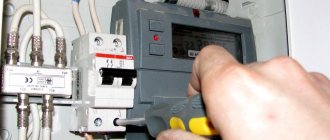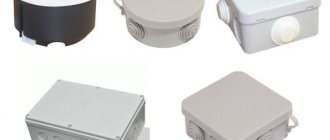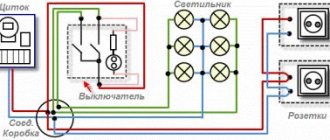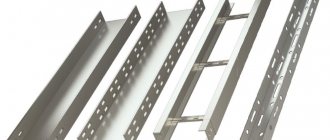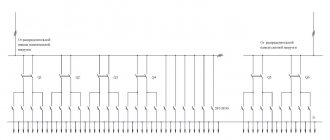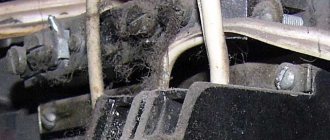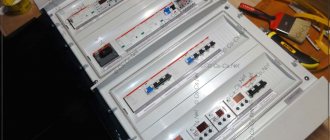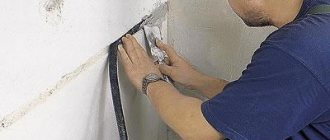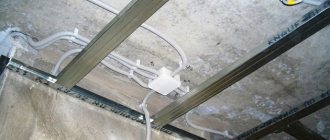Installation of a distribution box in an apartment is an important stage of electrical wiring; thanks to it, the electric current is evenly distributed to points that consume electricity (lamps, sockets, switches). A properly installed box ensures 100% uninterrupted use of electrical wiring. In appearance, the junction box is a metal or plastic structure with holes on the sides. Wires extend from the box, which provide current to all important electrical devices.
What is a junction box for?
To distribute electricity evenly, the wiring is divided into separate groups of consumers. In rooms, distribution boxes are installed at the wiring connections.
Distribution boxes perform several important functions in residential premises:
- ensuring fire safety;
- creating an aesthetic appearance in the apartment.
The wires are located inside the box; thanks to the housing, they are not subject to mechanical stress, which ensures their safety.
According to the installation principle, the boxes are built-in and external. Built-in ones are installed in specially prepared recesses in the wall, and overhead ones are fixed on the wall surface.
Installation
When installing distribution boxes, it is important to select the device model in accordance with the climatic conditions of the operating environment. In the room, the number of mounting elements is selected in accordance with the diagram. As a rule, 2–3 distribution boxes are used per room, but this is not necessary; their number can vary individually.
The installation location is selected along or in close proximity to the main line from which the tap will be made. Most often, this is the ceiling space where the cable is laid, which allows you to save extra meters of conductor products. However, in accordance with clause 2.1.23 of the PUE, the installation site must provide the possibility of inspecting contact connections.
The hole size is designed for the box
The size of the hole is developed for a specific box - first the diameter and depth of the product are measured, then the required space is drilled for them. Please note that for plasterboard walls, the hole is drilled end-to-end without reserve. But in solid structures, the excess space will be filled with a solution of putty, cement or alabaster.
Provide a reserve length of the cores connected in the box
The cores of the connected wires are brought out into the landing space. For connection and ease of work in the future, a margin of at least 10 cm is made. If several branches from different lines are planned in the box, the cores should be marked so as not to get confused.
Label the wires for connection in the box
If there are no factory holes, they are formed in the junction box with a screwdriver or other tools. The insertion location and diameter are selected individually.
After installation, the junction box is aligned with the wall level. If the solution protrudes at the edges, it must be removed with a spatula so as not to take up excess space.
The box is installed flush with the wall
Please note that inside the box the wires must have both a margin of length and a margin of space. Once installation is complete, the distribution fittings cover should close tightly and be in place.
When installed, the cover fits tightly to the wall
Main function of distribution box
The distribution box allows you to reduce wiring costs. If it didn’t exist, each electricity consuming device would be connected with a separate cable. The absence of a box provides for an increase in the channels for laying wires, and visually this looks unaesthetic.
The advantage of using junction boxes is undeniable, and proper connection of wires will ensure the safety of the premises. This device isolates contact points from the effects of flammable wall materials.
The ease of use of the junction box ensures ease of repair. The main function of the box is that it ensures uniform distribution of electricity to the locations of the main consumers. In addition, such designs of switching boxes involve adding new branches of electrical networks to the existing wire if necessary.
Reliability of junction boxes
When considering such a scheme, the question immediately arises: how will the use of boxes affect the reliability of the entire structure? There are so many connections, and even so many consumers on one wire... That is why there is an opinion that distribution boxes are evil.
It is worth slightly disappointing the skeptics. With correctly selected junction boxes and types of connection of wires of the appropriate cross-section, reliability will practically not suffer. It will decrease somewhat if, say, there is a flood from above (the boxes will be flooded with water), but, firstly, this situation is abnormal, and secondly, a correctly made connection will not survive such a thing. Well, if you have regular floods, you can use special waterproof junction boxes with terminals. And in general, even if the reliability of the electrical wiring decreases by a couple of percent, it’s worth it, since you don’t have to tear apart the entire house to find the slightest fault, and then completely destroy it in order to eliminate this fault.
Types of distribution boxes
Distribution boxes according to the type of fastening are divided into:
- overheads, which are installed outside on the wall;
- internal, installed in the prepared wall recess.
The main purpose of the junction box is to provide easy access to the electrician in the event of a system malfunction. For convenience and to preserve the integrity of the wires, the box is closed with a lid. To carry out any manipulations with the electrical wiring, specialists just need to remove the cover and get acquainted with the causes of the problems.
Distribution boxes are made from the following materials:
- Plastic.
- Metal.
Metal cases are made of tinned steel sheets or aluminum alloys. The main requirement for materials is that they are not subject to corrosive changes.
If a distribution box is needed for strategically important facilities, then it must be selected with the following characteristics:
- screw cap;
- waterproofing gaskets.
The metal case has universal properties and perfectly protects the wiring during a fire, that is, during a fire, the metal structure is able to preserve the contents of the box for some time, during which it is possible to de-energize the network.
The plastic case also has positive properties: resistance to oxidative processes and the ability to isolate electric current.
Distribution boxes vary in geometric shape and are:
- round;
- square;
- rectangular.
If a small number of wires are supplied to the box, then a round box configuration can be used. In cases of a large number of wires, it is better to use a rectangular distribution structure.
Important! If the walls are concrete, then it is easier and more convenient to install round box structures.
The dimensions of distribution boxes depend on the number of wires and their cross-section.
What devices are there?
Modern devices come in two types:
- Internal or hidden.
- External or overhead.
Junction boxes for hidden wiring (right) and overhead type
The former are used, as a rule, for installing hidden wiring, the latter for external wiring. The materials used for their manufacture range from ordinary or non-flammable plastic to metal. It is recommended to ground the latter, although this is often not done out of laziness or negligence. Both of them can have either a regular design or a waterproof or even sealed version. The last two are used in high-risk areas - damp and explosive (basements, warehouses, ships, etc.). The differences between internal and external boxes are not only aesthetics, but also ease of installation. For example, it is much easier to use internal distributors for hidden wiring.
Internal structure of distribution box
The design of the junction box consists of a housing and a cover, as well as side inlet holes.
The internal cavity of the box is equipped with terminals and clamps for fastening wires. Typically, the input cable is secured using terminals, and separate wires are secured using clamps. If the box is not equipped with terminals, the wires are secured together by twisting.
The disadvantage of a terminal connection is that after use the bolts can become loose and disrupt the wiring contact. Loose contact causes heating and subsequently burning of the wires. Twisting is considered a more reliable method.
It should be taken into account that the connection of aluminum and copper wires in the junction box leads to destruction of the connection and the occurrence of an electrochemical process.
Important! Brass terminals provide high-quality connection of aluminum and copper wires.
Material of manufacture
Manufactured from materials that provide maximum protection for the entire service life. Most often, high-quality plastics are used in production. However, sometimes you can find metal boxes. They are made from stainless steel, so they will never rust. In case of fire, a metal structure will be more reliable.
Metal distribution boxes
A plastic case may provide less reliable protection. Some models are completely sealed and can spend some time in water. When struck by fire, the plastic case does not burn, but begins to gradually melt.
Installation
During electrical installation work in houses of concrete or brick construction, electrical devices are placed in the wall cavity in specially prepared holes in the wall. Such recesses are made with a hammer drill; in cases of a round design of the distribution panel, the holes are made with a special crown. In the seat, the box is attached to the wall using alabaster mortar, which guarantees a strong connection between the housing and the wall.
After determining the installation location of the box, you need to prepare the wire network and make the connection. In order to bring them to the switching box, you need to prepare grooves into which the wires will be laid. If the walls allow the possibility of wiring in a horizontal position, then the gaps between the walls and the ceiling are quite useful for this.
After preparing the channels and socket boxes, the wiring of the switching box wiring system is carried out.
Important! To ensure the correct connection of the wires in the junction box for the purpose of quickly carrying out subsequent repair work, the wires are marked.
The input cable from the electrical panel is designated as “input”; the wire from the sockets should also be marked, because labeled wires will not allow mistakes during maintenance and repair. In order for the wires to be used correctly, the cross-section must be strictly observed; for example, to supply electricity from the panel, a two or three-core cable with a cross-section of 4 square millimeters is used.
Such a cable guarantees full use of any high-power consumer. For the lighting system, a cross-section of 2.5 square millimeters is used, and for sockets - 1.5 square mm.
After familiarizing yourself with all the nuances, they begin to install the junction box. The basic principle of installing the switching structure is indicated by precise adherence to the sequence of wiring connections. The wiring diagram in the distribution box includes the following parameters: phase is connected to phase, zero is connected to zero, and grounding is connected to grounding.
Laying of wires occurs subject to compliance with all parameters and requirements of the drawn up connection diagram. The wires are laid inside the box, preferably with an allowance of about 10 centimeters. When connecting wires, it is necessary to strip the ends of insulation and secure them in the terminals.
If there are no fasteners, you can simply fix the connections by twisting. This method involves twisting the wires at the points of contact; this method is often used and is considered reliable. After this, the joints are fixed with insulating material (insulating tape or plastic caps).
Important! The wires are mounted in pipes made of metal or plastic, which provide insulation from external negative factors.
Various modifications of switching devices are widely presented in specialized electrical stores. The included instructions indicate the main characteristics and current voltage ratings.
Wiring diagrams
It is necessary to become more familiar with the features of connecting the wiring from the junction box to consumers.
Prices for various types of voltage indicators
Connecting sockets
Often sockets are connected in groups on one line. So, 3 cables with several conductors are placed inside the box. Brown indicates the phase conductor, blue indicates neutral, and green or yellow indicates ground. Of course, some manufacturers use other colors.
The wires are laid out on a flat surface, and then cut to a certain length, but with a margin (so that it can be separated again). Next, it remains to fix them according to the diagram.
Connecting a switch with one button
This is where installation becomes more complicated. After all, there are three groups of electrical wiring with different connections. One conductor is responsible for supplying voltage from another box or panel, the second comes from the lighting fixture, and the third from the switch.
The phase conductor is fed to a switch, which is connected to the lamp. Here you should make sure that the voltage supply occurs precisely when the switch is closed. The neutral and grounding conductors from the lamp are connected to the shield.
Connecting a switch with two buttons
A three-core cable is connected to this type of switch (without a grounding conductor, because it is connected directly to the panel). The first conductor goes to the common contact of the switch, the second to the first button, and the third to the second button.
Note! The phase conductor is connected to the common contact, the zero is fixed directly from the board and lamps. The phase wires from the lighting fixtures are fixed with the cores on the buttons.
Connection principles
For quick connection and to avoid confusion, the wires are marked with colors of different shades. The following color combination is considered popular: white indicates phase, blue indicates zero, and light green symbolizes grounding. When connecting, strict compliance and consistency must be observed.
Like any other work, electrical wiring in a junction box also begins with a design. To draw up a competent electrical wiring diagram, you need to determine the exact location of electrical installation points - lamps, sockets, switches. In accordance with the diagram, distribution boxes are placed in convenient places. Providing access is necessary for carrying out repair and maintenance work in case of interruptions in the electricity supply.
The rules for electrical installations stipulate that wires must be connected by soldering, welding or using clamps. However, the “old-fashioned” method of twisting wires has proven itself among the people; this method ensures the manufacturability and reliability of the system.
Sometimes twisting the wires is not enough; to ensure reliability, the contact area is treated with soldering. After connecting, the wires are insulated and placed in the box body so that they do not come into contact with each other.
After carrying out the entire complex of work, diagnostics are carried out; for this, the most powerful electrical appliance in the apartment is connected to the network and the wires are checked for the presence of heating. If you find any wire heating up, this means that it does not have enough contact area, and in such cases the junction box should be repaired, possibly replacing the wire with a larger cross-section wire.
Where is it used?
Distribution boxes are designed for wiring and installing sockets and switches in solid parts of brick and concrete walls. They are installed in hollow walls or partitions, in various electrical installation products, in particular, dimmers. Those types that are intended for outdoor installation are used in environments with high humidity, dust, chemical and corrosive aggressiveness.
Wiring around the house
They are needed to create durable, safe, controlled wiring, telephone connection, socket, switch, dimmer and communication device. Distribution and mounting boxes protect cable connections of cores from external influences. They create an aesthetic appearance of the interior and facade.
You might be interested in: How does electric current affect the human body?
Types
Depending on the method of laying the electrical wiring of the room, distribution boxes are divided into:
- twist;
- connection using terminals built into the junction box;
- self-insulating clips (PPE);
- crimping (twisted wires are placed inside a copper sleeve, crimped with a special press);
- welding or soldering.
During electrical installation work, you should not abuse wire connections, since no crimping or welding can be more reliable than an intact cable. A large number of switching nodes increases the likelihood of electrical wiring malfunctions; in addition, distribution boxes must be in the public domain to be able to repair them, which is difficult when there are a large number of them, so boxes should be installed where they are really needed. At the same time, the desire to reduce the number of distribution boxes leads to significant cable consumption, so when planning work, a balance should be found between these factors.
An example of the optimal location of distribution boxes is shown in the picture below
Shell protection degree
There are seven types of junction boxes according to the degree of protection:
- IP 20 for electrical appliances that can only be used in a dry room. Such products are not protected from water, snow and other liquids;
- IP 30 for devices located in dry rooms, since such equipment is not equipped with moisture protection;
- IP 44 for devices with limited use outdoors, in damp places, under a canopy and canopy, in rooms with high humidity;
- IP 55 for electrical equipment exposed to weather conditions, protected from dust formation and temporary ingress of moisture. Common electrical installation models of distribution boxes. Often, many manufacturers of electrical and technical products indicate exactly the presented IP degree;
- IP 65 for electrical devices highly exposed to precipitation. Such distribution boxes are considered completely protected from dust particles and water and can be used outdoors;
- IP 67 for electrical equipment exposed to strong weather conditions. Boxes that can be placed on the ground or directly in the ground;
- IP 68 for devices that can be submerged in water.
As for choosing a product according to the degree of protection, it is necessary to purchase a junction box depending on the operating conditions. To install a socket box in an apartment, it is enough to use IP55. In 99% of cases they perform their function perfectly.
First degree of protection
Important! In order to maintain the degree of protection during installation, it is necessary to protect the inputs of such products with glands according to the diameter of the cable, PVC pipes and corrugations.
Design features
The product for its intended purpose must be small in size and provide effective and high-quality insulation of wiring connections from negative influences. Most of the devices on the market have a round, square or rectangular body, in which there are technological holes for laying electrical circuits inside.
Devices for external mounting have different types of fixation to the wall:
- the housing may have external holes;
- the device is equipped with internal holes for mounting;
- external devices can be used for installation on special tension lines and equipped with special fasteners for fixing on a cable.
In internal devices, fittings are installed in the wall itself or in drywall. The main feature of products for concrete walls is the possibility of fastening using putty or plaster. For better fixation, special holding elements located on the outside of the device are used. Fastening to a gypsum partition can be done using bolts that are installed through holes in the bottom of the product.
The outer cover is usually secured using latches or bolts. Internal products that are simple in design can be secured using special latches. Some devices may incorporate protective grounding technology. Such devices are equipped with a special strip with holes; it is used for high-quality fixation of the electrical grounding circuit.
Characteristics
The PROMRUKAV channel talked about the technical characteristics of switchgears.
The characteristics of distribution boxes differ from each other:
- material of manufacture;
- overall dimensions.
Material
Most often, distribution boxes are made of plastic.
The use of this material for production is due to the following advantages:
- plastic has excellent dielectric characteristics;
- plastic is a cheaper material, which generally reduces the cost of production;
- thanks to plastic, the manufacturer can produce junction boxes in any shape and size;
- plastic devices can be additionally equipped with rubberized sealing elements, mounting strips, and bolts;
- Products made of plastic are characterized by a long service life due to the fact that this material is not destroyed during operation.
Metal devices have higher performance properties. Thanks to this, their installation is possible in warehouses, as well as production hangars and workshops. In a word - in any places where you need to firmly fix cables and prevent the negative impact of external factors. Devices made of metal are usually installed by stamping, followed by priming and painting. The lid is attached to the product via a screw connection, and high tightness of the box is achieved through the use of sealing elements and a rubberized seal.
Dimensions
Devices for hidden wiring come in sizes:
- 100x100x50;
- 80x80x40;
- 200x150x80;
- 240x190x90 and others.
The overall dimensions of the device will be different depending on the shape in which the device is made - round or rectangular. The depth of a round box can be 4-5 cm, and the diameter can be from 6.5 to 8 cm.
Rectangular sizes can be as follows:
- the depth of the device, depending on the type and manufacturer, will be from 3.5 to 9 cm;
- the length of the device can be from 4.3 to 38 cm;
- device width - from 7 to 30 cm.
In the video, Andrey Kalugin talked about distribution boxes of different sizes and types.
